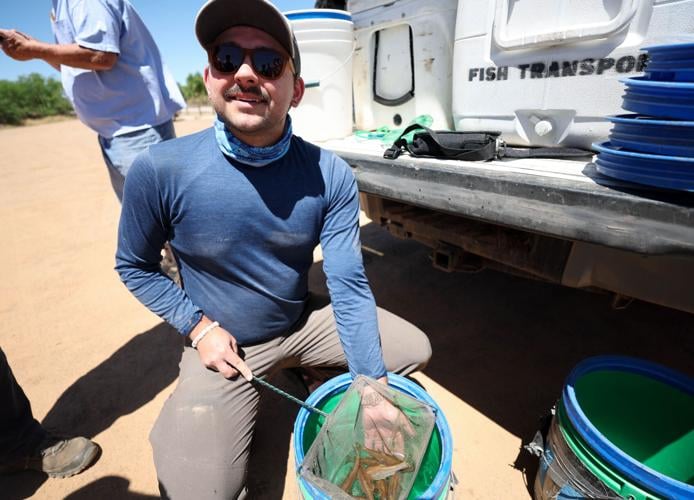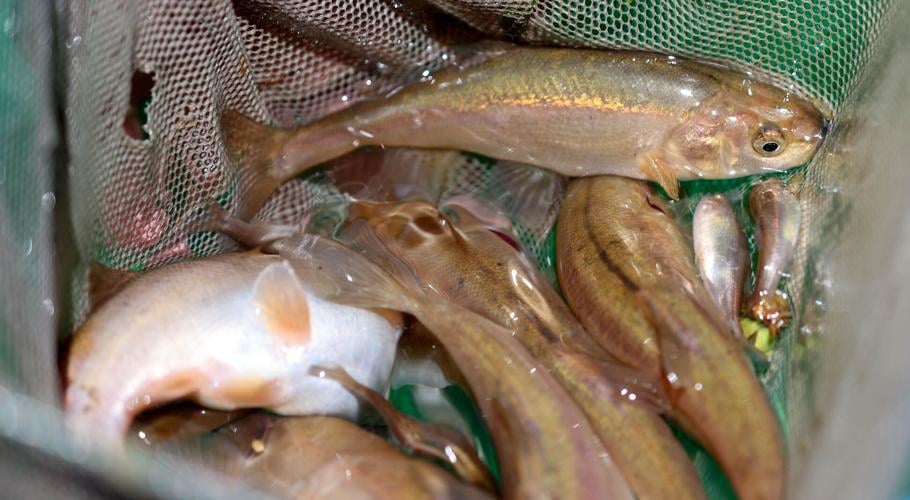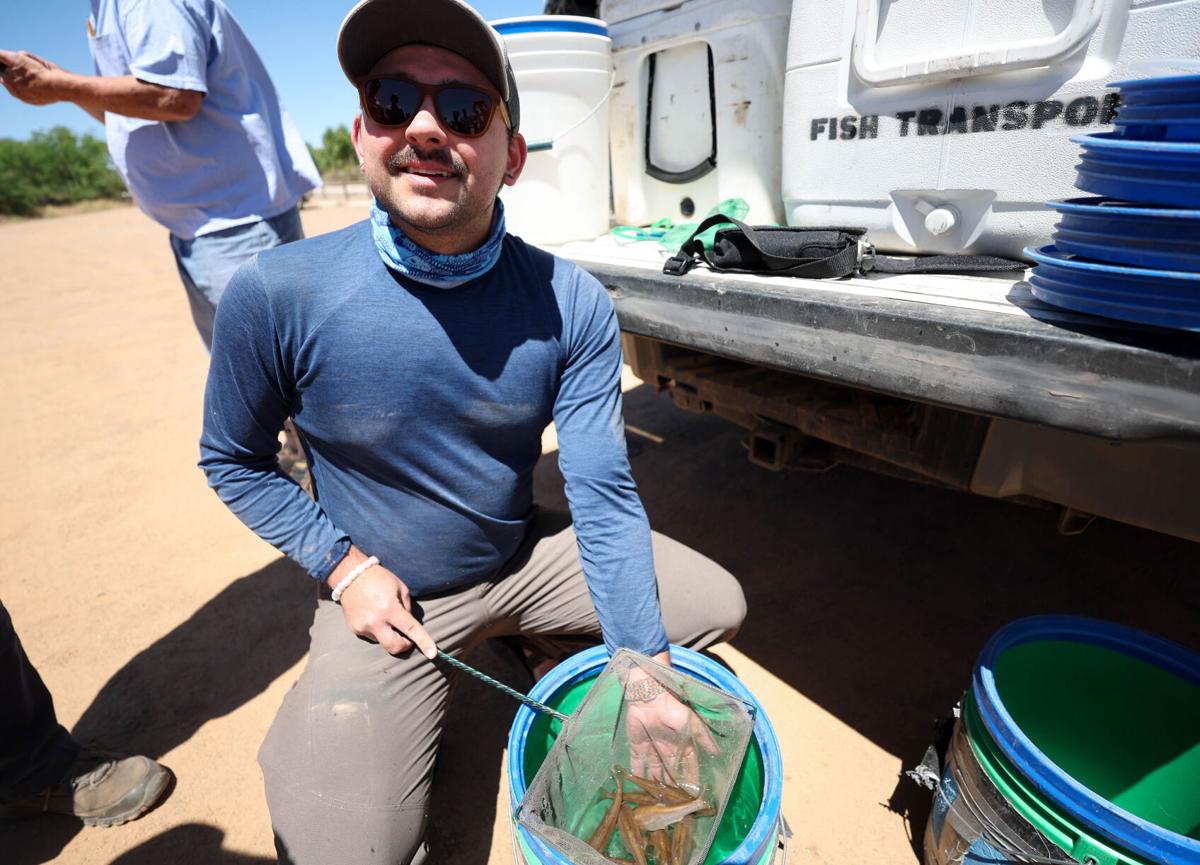A rare Southern Arizona fish left isolated by human activity is spreading out again, this time by truck.
On Tuesday, more than 100 Gila chubs caught a ride in the back of an Arizona Game and Fish Department pickup from Las Cienegas National Conservation Area near Sonoita to their new home at Pima County’s Historic Canoa Ranch park, about 35 miles south of Tucson.
“They had a little bit of a bumpy ride coming out of Las Cienegas, but they’re doing good,” said Brett Montgomery, a native fish specialist with Game and Fish, as he unloaded the chubs at Canoa Ranch. “If they’re swimming, they’re doing good.”
A total of 111 Gila chubs — ranging from one-inch youngsters to adults as much as 6 inches long — were released into Canoa’s human-made pond, where state and county wildlife officials are hoping to establish a reserve stock, just in case something happens to the few remaining native populations.
The brown and gray fish with the forked tail made the roughly 55-mile road trip in large water-filled coolers stenciled with the words “Fish Transport.” They were greeted at Canoa Ranch by a contingent of park staff members, volunteers and officials from the Pima County Natural Resources, Parks and Recreation Department, who each got the chance to release a few fish into the pond.
Like other aquatic species in the desert Southwest, the Gila chub can only be found in a fraction of its historic range, where it is under threat from water diversions, habitat loss, climate change and predation by non-native game fish and bullfrogs.
It is one of 44 species covered under Pima County’s Multi-species Conservation Plan, the 2016 agreement allowing development to continue for 30 years in exchange for habitat restoration and other mitigation work benefiting native plants and animals that are endangered or could be in the future.
Bureau of Land Management fisheries biologist Christina Perez came to see off “her” chub on Tuesday afternoon as they were released into the pond.
“These are my fish,” she joked.
Perez helped catch the transplants using passive hoop nets that were placed in Cienega Creek on Monday and baited with dog food. When they checked the nets the next morning, she said, they had also caught other kinds of native fish, along with quite a few Sonoran mud turtles.
The BLM-managed Las Cienegas National Conservation Area is home to healthy populations of native fishes and other aquatic species along stretches of Cienega Creek that have been cleared of non-native predators.

A batch of native roundtail chub sit in a bucket before being released at Canoa Ranch.
Canoa Pond, meanwhile, is one of more than 40 mostly artificial locations in Southern Arizona where Game and Fish has introduced endangered fish as part of the U.S. Fish and Wildlife Service’s Safe Harbors Program, which covers several species, including the desert pupfish and Gila topminnow.
The 2.5-acre pond just off Interstate 19 was filled in 2018 along an otherwise dry stretch of the Santa Cruz River.
The chubs will share their new safe harbor with a refuge population of desert pupfish that is thriving after being released there in 2020.
Ian Murray from the county’s Office of Sustainability and Conservation said the new arrivals will probably eat some pupfish, but there are thousands of them in Canoa Pond so the chub pose no real risk to the overall population there.

Ian Murray, the conservation science manager for Pima County, releases a batch of native roundtail chub in the pond at Historic Canoa Ranch.
Such refuges are important, especially for rare and vulnerable aquatic animals only found in a few scattered desert locations. Without a reserve population, one catastrophic event — a wildfire, a drought or a chemical spill — could finish off an entire species.
“It’s not theoretical,” said Sami Hammer, ecological monitoring program coordinator for the county.
The reason there are still Gila chub in Sabino Creek today, for example, is because more than 950 of the fish were captured and moved out of the canyon in 2003, before their habitat was severely damaged by a flood of debris washed down from the Aspen Fire in the Catalinas.
Murray said the fish were later reintroduced to Sabino Creek after the threat was over.
A similar rescue operation was staged during the Bighorn Fire in 2020, but Sabino Canyon did not see the same level of flood damage that time, he said.
The Gila chub is actually in the midst of an identity crisis.
It was once thought to be its own distinct species, but taxonomists now classify the fish as part of the broader population of roundtail chubs found throughout the Colorado River system from Colorado to Mexico.
Murray attempted to explain the difference this way: “All Gila chubs are roundtail chubs, but not all roundtail chubs are Gila chubs,” he said.
But even though the roundtail chub is also in decline for many of the same reasons as its Gila cousin, federal officials have so far rejected calls to add the roundtail to the endangered species list.
The important thing, Perez said, is that the Gila chub is still considered an endangered species, and the ones in Cienega Creek and elsewhere continue to be managed as such.
As for the new chub colony at Canoa Ranch, Murray said additional infusions of transplanted fish will probably be necessary over the next several years to increase the genetic mix and give the reserve population the best chance for survival.
Gila chubs are usually found in creeks, where they seem to gravitate to the deepest pools they can find, so Montgomery expects the transplants to do just fine in their new home. After all, he said, Canoa Pond has plenty of deep water and lots to eat.







